Theres no doubt about it; the AR-15 has gone mainstream. Over the last several years, the growth in demand for black rifles has lured many manufacturers (including the big guys) to introduce their own versions of the venerable Eugene Stoner direct-gas-impingement design. Now that the market has matured, we are now seeing engineering departments introduce versions that are claimed to improve upon the original AR-15 through the use of gas-piston systems.
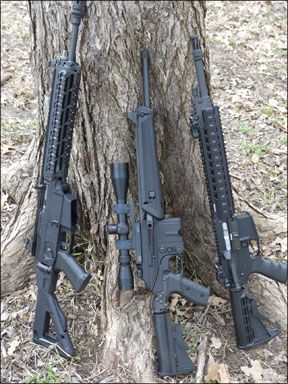
In January, we compared a new piston gun, the Ruger SR-556, to two direct-gas-impingement units, rating the Ruger an A- in the process. This time, we put the Ruger SR-556FB, $1995, apples-to-apples against two more gas-piston models, the Kel-Tec SU-16 CA, $890 as tested; and a Sig Sauer 556 Classic SWAT No. SIG556302, $2399.
In the original AR-15, gases are vented back through a gas tube to work the bolt and bolt-carrier group. The entire assembly works as its own piston. Since all of the gas is vented back to the bolt, fouling and heat build up in the mechanism. A piston system uses exhaust gas to work an exterior piston and operating rod assembly, greatly reducing the amount of spent gas that reaches the guns action. In our tests all three of our guns ran with less fouling than we see with our regular AR-15s.
The SIG556 and the Ruger SR556 use adjustable gas pistons, allowing the user to change the piston setting to optimize its operation for different ammo and operating conditions. The Kel-Tec uses a fixed gas piston in its design.
How We Tested
All of our testing was done in the climate-controlled atmosphere of Bass Pro Shops in Grapevine, Texas, sparing us from the ravages of a record cold snap. We started by mounting a Sightmark 3-9 X 42 (SM13016) Scope on a LaRue Tactical LT-104 QD Scope Mount. This lever-throw mount allowed us to move the scope quickly but securely among our flat-top equipped test rifles. The Sightmark had a smaller frame that balanced well with our guns, and featured an illuminated reticle to aid in low-light settings. Our target range was 50 yards.
The second portion of our testing involved utilizing iron sights at a shorter distance of 25 yards. We proceeded to fire 30-round magazines at a range-limited speed of one round per second to evaluate each guns handling and responsiveness in a dynamic situation.
After that, we also checked to see how cool the guns ran. The primary claims associated with gas-piston guns are that they run cooler and cleaner than comparable AR-15 direct-gas-impingement designs. It was fairly easy to disassemble each gun to look for carbon build-up, but verifying operating temperatures required a different approach. We devised a test protocol for this measurement through the use of an
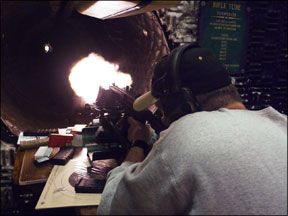
infrared thermometer. We decided on three points of measurement for our guns: the bolt, the chamber, and the end of the barrel. We verified the room temperature and the surface readings on each gun prior to testing. Then 30 rounds were fired through each gun and surface temperatures were taken immediately thereafter. To complete our comparison, we added a fourth gun to our testing: a direct-gas-impingement Stag Arms 2TL AR-15. The obvious temperature variation occurred at the bolt, where the DGI-mechanism AR-15 saw a rise of 33 degrees. The highest temperature rise among the gas-piston models was the Kel-Tec, which rose 10 degrees. The Ruger and Sig Sauer showed temperature changes of 8 degrees and 4 degrees, respectively. Full results appear in the table on page 15.
We could see that there could be long-term benefits in the cooler operating temperature of the gas-piston systems, although we did not see the AR rise to an exceptionally high level. A more extensive thermal test will be conducted in the near future.
Heres how the rest of our evaluation turned out:
Kel-Tec SU-16CA 5.56mm NATO/223
Rem. $770, $890 as tested
Florida-based Kel-Tec CNC Industries Inc. has carved a niche in manufacturing small, lightweight pistols which feature simple no-nonsense designs. The SU-16CA follows this same philosophy. The barrel and mechanism are constructed 4140 steel with the balance of the gun constructed of Zytel, a reinforced plastic polymer. Additionally, the barrel is chrome lined for corrosion resistance and has a twist of 1:9. It comes with -28 threads, but no flash hider is supplied. Instead, a knurled cap serves as a thread protector. The SU-16CA was by far the least expensive rifle in our tests, coming in at a little more than a third the list price of the Sig Sauer.
When we unboxed our test rifle we found that it came packaged… in the box. No pretense was even made in supplying a thin plastic carrying case. Our first reaction when eyeing the gun was not unlike the one we had when holding a Glock for the first time. Gads, there is a lot of plastic on the gun. This combination did make for a lightweight set-up, as our model weighed in at a little over 5 lbs. We did replace the standard folding stock with an optional collapsible version ($120). This bolt-on replacement had an integrated pistol grip and includes the trigger group for the gun. Adding the stock brought the Kel-Tecs weight up to a still-svelt 5.4 lbs. The plastic forend had molded checkering and becomes a bipod by splitting in half, and folding forward. An optional AR-style compact forend ($48) was also provided, but we chose to leave the full-length version in place. We did note the Kel-Tec did a very good job in molding textured areas on the SU-16CA. We found that holding the gun was secure, and found the pistol grip particularly comfortable. Two plastic 10-round magazines are supplied with the rifle, and it can accept standard AR magazines as well.
Once we reconfigured our gun to the retractable version, and made sure to align and tighten the stock and trigger assembly, we took trigger-pull measurements. We noticed a slight clicking sensation as the trigger was taken up, followed by relatively clean break at a slightly higher than advertised 7.1 lbs. The testers all rated the Kel-Tecs trigger as average for a defense-style rifle.
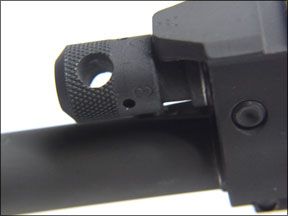
The SU-16CA differed quite a bit from an AR in its control location and operation. The Kel-Tec uses a side-mounted operating handle rather than a charging handle It is made of plastic and has a series of molded ridges on it to assist in grasping it. The lever reciprocates upon firing and acts as a brass deflector. We did note that this surface did become nicked from ejected brass during the course of our testing.
The bolt head is an AR-15 style, and locks open when the magazine is empty. The gas piston system on the Kel-Tec is non-adjustable, and is reminiscent of one found on the AK-47. The magazine release consisted of a plastic rectangular button located just forward of the trigger guard. The safety was a crossbolt configuration located above and slightly behind the trigger guard. It was beveled on the left side and cupped on the right. Firing position is achieved when the bolt is pushed from the right to the left. The bolt lock/release is located on the bottom of the SU-16A adjacent to the mag well. It is not readily detected, and a couple of our testers were rummaging around the gun in an effort to find it.
The sights on the SU-16CA consisted of a partially hooded sight post that can be adjusted for elevation and a single aperture rear peep sight. The rear sight is adjusted for windage and elevation by repositioning the sight up and down the flat-top rail and by using a pair of Philips-head tensioning screws. The sights on the Kel-Tec were by far the hardest to fine tune of our three guns, and the least accurate.
Accuracy testing found the SU-16A to be surprisingly well behaved despite its light weight. It lagged just behind our other two test rifles with all three types of ammo tested, turning in a best average group of 1.4 inches with the Remington 55-gr. MC loading. The piston in the Kel-Tec seemed to moderate the felt recoil and supplied consistent performance with no malfunctions. Empties were thrown slightly forward with some inconsistency in their pattern.
The action testing of our gun proved to be problematic. The first shot elicited a note of surprise from our tester on the firing line and others inside the rifle tunnel of Bass Pro Shops, as a watermelon-sized ball of flame leapt out of the barrel. The iron sights were completely overwhelmed by the fireball, making fast firing at 25 yards all but impossible. We had to move the target to the 15-yard mark to allow us to overcome the flashbulb vision effect to complete our testing. Our Team Said: Despite the operating problem of the fireball, several of our testers came away more impressed with the SU-16CA than their first impression had given them. It was agreed that after a flash hider was added, the Kel-Tec would make a good backpack or in-vehicle rifle.
Ruger SR-556FB Model 5902 5.56mm
NATO/223 Rem., $1995
Rugers foray into the AR market was announced with a flourish in May 2009. Instead of entering the crowded realm of AR-15 clones, Ruger chose instead to design its own proprietary semiauto piston system and incorporate it into full-featured offering. The SR-556FB comes only one way from the factory and that is fully equipped. It appears that Ruger attempted to cater to the new AR owner by making a number of equipment choices for the buyer.
The SR-556FB sought to differentiate itself from other black rifles right out of the box, cradling the gun in a custom cloth case with the red Ruger logo on full display on its front. The case wasnt bad, but wed like a bit more padding and a much heavier zipper than the one on our sample. Our gun also included a pair of Magpul polymer 30-round magazines, a design we found to be quite dependable.
Beginning our inspection, we found that the 16.1-in. barrel was chrome-lined and made of chrome-moly-vanadium steel and (thankfully) topped with an AC-556 flash suppressor. These parts were all manganese-phosphate coated along with the gas block and regulator. The lower receiver was made of aluminum and hard anodized. Ruger chose to chrome-plate the bolt assembly, which made for a nice appearance. The Ruger emblem was also engraved on the bolt as well. In fact we noted the Ruger logo appeared in no less than eight different places on our test gun-a definite branding effort.
The SR-556 had the standard AR-15 configuration of charging handle, mag release, dust cover, forward assist, and left-side-only lever safety. The stock was Ruger-branded, but was the standard M4 variety as well.
The other parts of SR-556 were upgrades over a standard AR. A comfortable Hogue Monogrip adorned
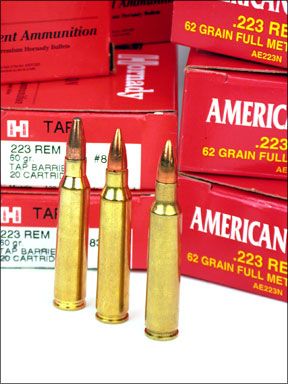
our gun, and a Troy Industries 11-in. Quad Rail wrapped around the barrel of the Ruger. This left plenty of space for all manner of accessories to be mounted. Troy Folding Battle Sights graced the top of our gun. The rear sight had dual apertures and was adjustable for windage, and came paired with a partially hooded front that offered elevation adjustment. We like this sort of sight configuration because it allows them to be co-witnessed with red dots and other CQB optics. This additional hardware, along with a heavier piston system, brought our gun in at 7.9 lbs.
The trigger on the SR-556 was a single stage version that broke very cleanly, but at a rather robust 8 lbs. Wed like at least a couple of pounds shaved off this pull weight.
The primary design difference between the SR-556 and a standard AR-15 is the Ruger proprietary gas piston system. The transfer or op rod was noticeably larger than a standard gas tube and was electroless tin plated. The gas block has a rotating dial on its end with four positions labeled 0 thru 3. This allows the gas output to be tuned to optimize the guns action with a variety of ammunition. At the fully open or 0 position, the gun becomes a single shot. For our purposes, we found the middle or 2 position worked well with all of the ammo we tested.
Accuracy testing revealed the Ruger handled all of our ammo relatively well, turning in its best group with the Remington 55-gr. MC at 1.2 inches, and fared only slightly worse with the heavier 63-gr. Silver State loading. Recoil was dampened well, and the gun functioned with no malfunctions. The Ruger SR-556 also fared well in our action shooting. The Troy sights proved to be much easier to line up and adjust than the Kel-Tec model. We found the gun to be steady and relatively easy to point, although our testers did find the gun to be balanced pretty far forward because of the long quad rails.
Our Team Said: It was obvious that Sturm Ruger spent quite a bit of time on the design and execution of the SR-556. New shooters will find its package well-equipped and easy to use. Experienced AR shooters will appreciate the inclusion of quality stuff that works.
Sig Sauer 556 Classic SWAT No. SIG556302
5.56mm NATO/223 Rem., $2399
The Sig Sauer Classic SWAT is actually the “Americanized” version of the Sig 550 Series, a gun that has been used in Europe for a number of years. It was sold in the U.S. market until the Bush Sr. administration and the later Assault Weapon Ban halted its sales. When Sig Sauer decided to reintroduce the gun through its New Hampshire manufacturing site, its design was altered to accept AR-15 magazines, and thus re-christened the 556. The 556 Classic SWAT comes fully loaded with accessories and a wealth of standard features. All of this comes at a price, however, $2399 to be exact-enough to buy the Ruger and more than 400 rounds of ammo, or three of the Kel-Tecs.
Still, this gun makes an impression right out of the box. It came packed in heavy-duty lockable case that we would actually use to carry the gun to and from the range. A single polymer 30-round magazine was included-skimpy, we thought, since the others came with two magazines.
The Sig 556 Classic SWAT had a 16-inch cold-hammer-forged barrel with a faster twist rate than our other competitors at 1:7. This faster twist is designed to stabilize the heavier bullets favored by todays military and law enforcement. It was topped with a bulbous flash suppressor with a birdcage-style configuration, threaded in -28 pattern. The upper receiver was steel and housed the barrel, bolt and operating rod and wore a coating that Sig Sauer calls Nitron. The lower receiver was made aluminum alloy and was hard anodized, and held the trigger assembly, stock, and pistol grip.
The Sig 556s action was activated by a side cocking lever, and featured the only ambidextrous safety of our test models. It was interesting to note that Sig Sauer recommends that the gun only be fired from a right-handed position, a likely concession to the U.S. legal system. Our two left-handed shooters violated this suggestion and emerged none the worse for wear. The lever on the left side of the lower receiver is used to lock the bolt back. A tug on the side cocking lever releases the bolt, allowing it move forward in the charged position. The magazine release was located just in front and above the trigger assembly.
The Sig Sauer utilizes a two-position gas piston with its control located in front of the gas block. Unlike the Ruger, the control knob turned easily by hand. In operation, only one position (vertical) is used to operate the gun. The second position is only used when the gun begins to run sluggishly, and Sig Sauer suggests cleaning the gun at your earliest opportunity when it must be used. Running the gun in this wide-open setting constantly can cause excessive wear on the systems moving parts.
The Sig Classic SWAT featured a stock that was both length adjustable and folding. When folded, the stock snapped onto a latching mechanism to lock it in place. This made the gun stowable. Our testers thought the pistol grip was on the smallish side, but adequate. It featured grooves and a palm swell that helped secure our grip.
The trigger also received compliments. It was a two-stage design with an overtravel adjustment screw located at the rear face of the trigger guard. The trigger required approximately 3.5 lbs. of pressure to activate the first stage, finally breaking at an indicated 7.3 lbs. Although heavier than we liked, the trigger felt responsive and controlled. Adjusting the overtravel allowed us to aggressively attack targets without even noticing the second stage in our action testing.
The Sig 556 had an aluminum quad rail that gave the gun an aggressive look but also had a peculiar set-up. The underside of the rail did not have a tapered loading ramp, making the addition of a vertical grip or flashlight harder locate on the rail unless it had an adjustable clamp design.
The sights on the gun were unique and were suited to be the primary sighting option if desired. The front sight was hooded and fixed in place. The rear sight was a rotary diopter design featuring four different settings. The first position was a close quarters open V design. The sight could then be rotated to 100-, 200-, and 300-yard peep sight options. It featured a rotating knob on the base of the sight to adjust elevation, and a knurled screw adjustment for windage on its side. We found the sight picture to be very good, and the sight could be easily zeroed.
Our range time confirmed the solid build quality of the Sig Sauer design. The gun ran smoothly without any missteps. Accuracy with the scope proved to be good with all the ammo tested. The 1:7 twist particularly liked the heavier 63-grain Silver State ammo, turning in an overall best average of 1.1 inches. The diopter does require a high mount to get a scope to fit over it, however.
Action shooting proved to be a strong point of the gun. At 50 yards, we consistently held center-mass groups that stayed within a 3-inch range. We did note that our spent rounds were ejected forcefully, often clanging off the side wall of the shooting room. Our chief complaint with the gun came from its 8.8 lbs. weight, which began to drag us down by the end of our tests.
Our Team Said: The Sig Sauer Classic SWAT had a full-featured list of options that our testers liked, and they were also impressed with its performance, in particular the two-stage trigger and the iron sights. But it was heavy and costly.





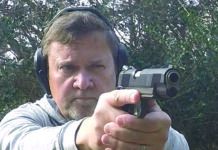


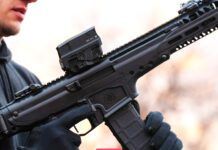
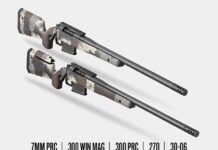
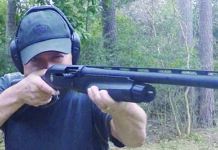
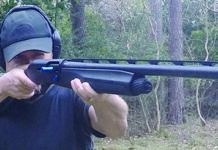
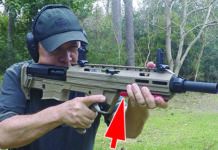






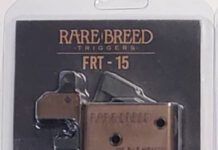


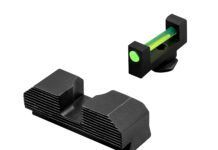









I have the pistol version of this weapons platform and it’s never skipped a beat in the five years I’ve been using it quite unique and very reliable!
I have the 556Swat pistol version of this weapons platform and it’s never skipped a beat in the five years I’ve been using it quite unique and very reliable!